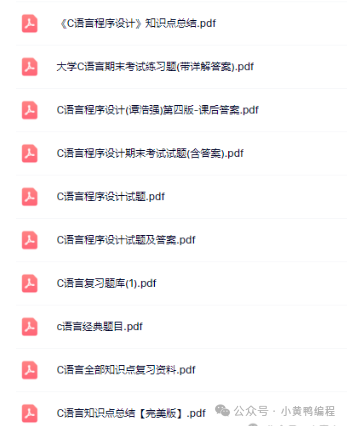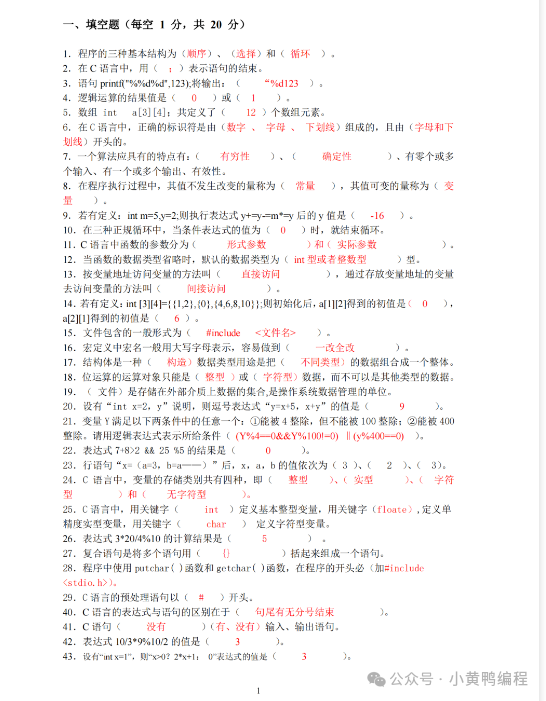C Language Final Exam Review: Key Points and Question Bank
The final exam is approaching. How is everyone’s review going? Do you feel overwhelmed by the numerous knowledge points? Don’t panic; keep a clear mindset, and studying is the way to go! This article is tailored for C language learners, covering key points and a question bank for the final exam! Quickly bookmark this “ultimate guide” to help you through a worry-free exam season!

Part One: Summary of Basic Knowledge Points in C Language
The key to effective review is to firmly grasp the fundamental concepts. Below are the basic knowledge points in C language that are frequently tested in final exams:
1. Basic Structure of a C Language Program
-
1. A program written in C language is called a “source program,” also known as a “compilation unit.”
-
2. The writing format of C language is very flexible—multiple statements can be written in one line, or a single statement can be split across multiple lines.
-
3. A C language program must have exactly one
mainfunction, as it is the starting point of program execution.
2. Program Execution Flow in VC++
-
1. **VC++** is a commonly used Integrated Development Environment (IDE) for writing and running C language programs.
-
2. The basic flow of program execution: Compile (.c) → Link (.obj) → **Generate Executable File (.exe)**. Note that
.cand.objfiles cannot be run directly; only the final.execan be used! (This is a common testing point!)
3. Identifiers and Valid Naming
-
1. Identifiers (high-frequency in exams): Valid identifiers consist of letters, digits, and underscores, where the first character must be a letter or underscore, and cannot be a digit; other characters are not allowed.
-
2. Classification of identifiers:
-
• Keywords: Cannot be used as user-defined identifiers. For example,
intandfloatare keywords. -
• Predefined Identifiers: Such as
printf,scanf,define, which can be redefined but may lead to errors if not used cautiously. -
• User Identifiers: Defined by programmers for naming variables, functions, etc.
-
• Easily Confused Points:
If(with uppercase first letter) is a valid identifier name, butif(all lowercase) is a keyword!

4. Common Number Systems and Conversions
In the final exam, converting between number systems is a headache but an unavoidable focus:
-
1. Decimal → Binary, Octal, Hexadecimal: Use the division-remainder method, dividing the integer part step by step by the target base, and collecting the remainders.
-
2. Binary → Decimal: Expand each digit according to its weight and sum them up.
-
3. Quick Memorization of Knowledge Points:
-
• Binary: Begins with
0bor0B. -
• Octal: Begins with
0. -
• Hexadecimal: Begins with
0xor0X(note case sensitivity).
5. Data Types and Variables
Review Focus: Size and Value Range of Basic Data Types—int, float, char, and double, with specific sizes depending on the compiler.
Part Two: Selected Questions from the Final Exam Question Bank
Is reviewing theoretical knowledge not enough for you? No worries, here’s a carefully selected question bank for the final exam! Let’s try a few questions for practice.
True or False Questions
-
1. C language requires that each line of the program must contain one statement. (×)
-
• Explanation: The writing format of C language is flexible; multiple statements can be written in one line.
2. Identifiers can contain letters, uppercase letters, underscores, digits, and the first character can be a digit. (×)
-
• Explanation: The first character must be a letter or underscore, and cannot be a digit.
Multiple Choice Questions
-
1. Which of the following options is a keyword in C language?
-
• A. scanf
-
• B. printf
-
• C. if
-
• D. Define Answer: C. Explanation:
ifis a keyword, while the others are predefined identifiers.
2. In C language, what is the main role of the main function?
-
• A. Express the structure of the program
-
• B. Indicate the starting point of the program
-
• C. Display information
-
• D. Declare variables Answer: B. Explanation: The
mainfunction is the starting point of a C language program, where execution begins.
Part Three: Appendices and Resource Display
Here are some visual resource screenshots to make the review clearer:


Conclusion: Learning C language is not difficult, but it is essential to have a method. Master the fundamental knowledge, practice the key points frequently, and closely follow the textbook—this is the “three-pronged approach” to tackle the finals. I hope this article can effectively reduce your study pressure! Quickly bookmark this review material, calm down, and study well; you can ace the final exam with ease!
Wishing everyone good results in the final exam~~~